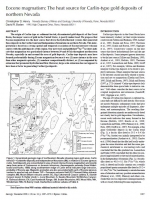Добрый день, Коллеги. Важное сообщение, просьба принять участие. Музей Ферсмана ищет помощь для реставрационных работ в помещении. Подробности по ссылке
Eocene magmatism the heat source for Carlin-type gold deposits of northern Nevada
The origin of Carlin-type or sediment-hosted, disseminated gold deposits of the Great Basin, the major source of gold in the United States, is poorly understood. We propose that Eocene magmatism was the heat source that drove the hydrothermal systems that generated these deposits in the Carlin trend and Independence Mountains in northern Nevada. This interpretation is based on a strong spatial and temporal association of Eocene intrusive-volcanic centers with the gold deposits of this region. Our new work and published 40Ar/39Ar dates indicate that magmatism was particularly intense between 39 and 40 Ma throughout northeastern Nevada, especially in and around the area of gold deposits. Carlin-type deposits may have formed preferentially during Eocene magmatism because it was (1) more intense in the area than other magmatic episodes, (2) somehow compositionally distinct, or (3) accompanied by extension that promoted hydrothermal flow. However, large-scale extension does not appear to have been a factor in generating Carlin-type deposits.
Carlin-type deposits in the Great Basin have been intensely studied, yet their origin remains controversial (Sillitoe and Bonham, 1990; Arehart et al., 1993; Kuehn and Rose, 1995; Thorman et al., 1995; Ilchik and Barton, 1997; Oppliger et al., 1997). Controversy centers on the heat source that drove hydrothermal flow and the age of the deposits. Some interpret igneous intrusions to be the heat source (Sillitoe and Bonham, 1990; Arehart et al., 1993; Hofstra, 1995; Thorman et al., 1995; Leonardson and Rahn, 1996; Groff et al., 1997). For example, Sillitoe and Bonham interpret Carlin-type deposits to be distal to porphyry intrusions. Others interpret the heat source to be elevated crustal heat flow related to extension and not to magmatism (Kuehn and Rose, 1995; Ilchik and Barton, 1997); Ilchik and Barton (1997, p. 273) claimed “Carlin-type deposits lack demonstrable time-space links to intrusive centers.” Still others consider the heat source to be coupled magmatism and extension (Seedorff, 1991; Oppliger et al., 1997).The age of Carlin-type deposits is debated because they are difficult to date directly. Host rocks are mostly Paleozoic sedimentary rocks that have undergone multiple episodes of diagenesis, alteration, and metamorphism. The resulting finegrained alteration minerals are neither easily dated nor clearly tied to gold deposition. Nevertheless, recent work indicates that many formed in the Eocene (Hofstra, 1995; Emsbo et al., 1996; Leonardson and Rahn, 1996; Phinisey et al., 1996; Rota, 1996; Groff et al., 1997). For example, at the giant Goldstrike deposit in the Carlin trend (Fig. 1), a dacitic dike dated as 39.3 ± 0.4 Ma (40Ar/ 39Ar; biotite) was initially interpreted to be postmineralization (Arehart et al., 1993). Emsbo et al. (1996) found that the dike had locally undergone the same alteration and had the same geo-chemical enrichment as ore-bearing rocks and concluded that the dike predated ore. Leonardson and Rahn (1996) concluded that this dike was em-placed approximately at the end of mineralization. In the Independence Mountains (Fig. 1), a basaltic dike dated as 40.8 ± 0.1 Ma (40Ar/39Ar; whole rock) is altered and locally contains ore; a weakly propylitized quartz monzonite dike dated as 39.2 ± 0.1 Ma (40Ar/ 39Ar; hornblende) is outside the main area of alteration and may postdate mineralization (Phinisey et al., 1996). Phinisey and others concluded that ore was deposited contemporaneously with or closely following Eocene magmatism.




